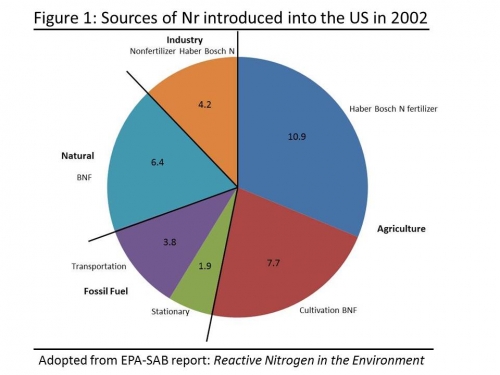EPA releases report on reactive nitrogen in the United States
The Environmental Protection Agency recently released a Science Advisory Board report on reactive nitrogen in the environment encouraging research and information gathering to improve N utilization in the United States.
 Reactive nitrogen (Nr) includes inorganic chemically reduced forms of N [ammonia (NH3) and ammonium (NH4)], inorganic chemically oxidized forms of N [nitrogen oxides (NOx including NO - nitric oxide and NO2 - nitrogen dioxide), nitrate (NO3) nitrous oxide (N2O)] and organic compounds [urea, amines, amino acids and proteins.] In August the US Environmental Protection Agency (EPA) released the agency’s Science Advisory Board’s (SAB) report on Nr in our environment titled Reactive Nitrogen in the Environment, an analysis of inputs, flows, consequences, and management options. According to the SAB report over 50% of the Nr annually introduced into the United States is attributable to agriculture activities, see Figure 1. The report’s authors estimate 34.9 Tg[1] N/yr. are introduced annually in the US. Of that total, 10.9 Tg is attributed to Haber Bosch N fertilizer and 7.7 Tg is from biological N fixating (BNF) legume crops. For additional information on Nr see What is reactive N and why should I care, a previous MSU Extension News for Agriculture article.
Reactive nitrogen (Nr) includes inorganic chemically reduced forms of N [ammonia (NH3) and ammonium (NH4)], inorganic chemically oxidized forms of N [nitrogen oxides (NOx including NO - nitric oxide and NO2 - nitrogen dioxide), nitrate (NO3) nitrous oxide (N2O)] and organic compounds [urea, amines, amino acids and proteins.] In August the US Environmental Protection Agency (EPA) released the agency’s Science Advisory Board’s (SAB) report on Nr in our environment titled Reactive Nitrogen in the Environment, an analysis of inputs, flows, consequences, and management options. According to the SAB report over 50% of the Nr annually introduced into the United States is attributable to agriculture activities, see Figure 1. The report’s authors estimate 34.9 Tg[1] N/yr. are introduced annually in the US. Of that total, 10.9 Tg is attributed to Haber Bosch N fertilizer and 7.7 Tg is from biological N fixating (BNF) legume crops. For additional information on Nr see What is reactive N and why should I care, a previous MSU Extension News for Agriculture article.
Nr is a water concern, air quality concern and a health concern. Nitrous oxide (N2O) is a greenhouse gas with 298 times the global warming potential of carbon dioxide (CO2). Ammonia and ammonium nitrogen contribute to atmospheric particulate matter (PM2.5) and eutrophication of forested areas and surface waters. Nitric acid and nitrogen dioxide (NOx) are air pollutants also contributing to PM2.5. Nitrate is linked to nitrates in ground water with its associated health risks and eutrophication of surface waters. These Nr forms are all incorporated within the N cycle directly associated with agriculture production. Because of agriculture’s contribution to Nr releases this report’s recommendations have the potential to impact future agriculture and N utilization practices.
Recommendations in the SAB report include:
- Increase data collection for N fertilizer application in major crop production areas, either by county or by watershed, to better inform the decision making process about policies and mitigation options for reducing Nr in these systems.
- Generate data on N fertilizer use efficiency and N mass balance for major crops to help identify crop systems and growing regions with the greatest opportunity for Nr mitigation and to better focus research, policy and prioritization of Nr mitigation practices.
- University and USDA research projects should prioritize systems that increase crop yields on existing land while increasing N utilization efficiency. Projects should also explore opportunities for diverse cropping systems with lower N fertilizer requirements.
- Research and education priorities should support more efficient N use and improved mitigation of Nr releases from N applied to agriculture crops.
- Rapid expansion of the biofuel industry has the potential to increase N fertilizer use. The SAB report encourages the development of an increased understanding of the relationship between biofuels production and Nr in the environment.
- A nationwide network of monitoring stations should be developed to monitor and assess NO3 and NH3/NH4 emissions from agriculture.
- Manure management should be improved to reduce Nr load and ammonia transfer from livestock operations.
While the SAB’s recommendations concentrate on monitoring, further research and information gathering, they do point to the areas of concern and where the SAB feels there is the potential for improved nitrogen use efficiency and reduced Nr introduction.



 Print
Print Email
Email




